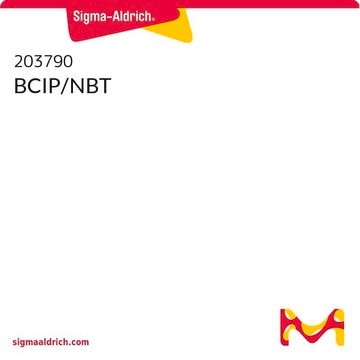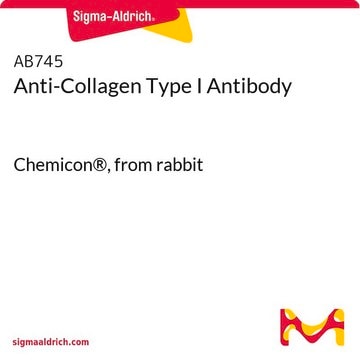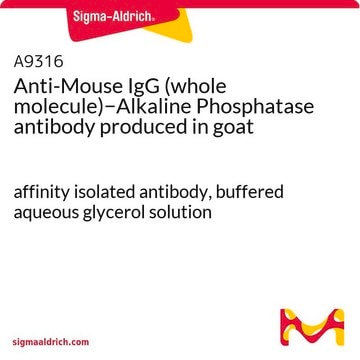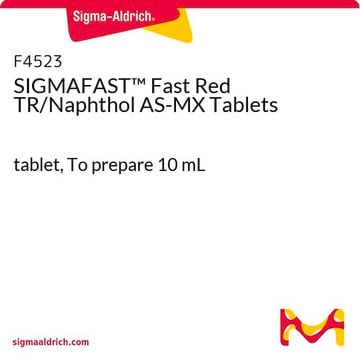B3804
BCIP®/NBT-Blue
alkaline phosphatase substrate, chromogenic, liquid
Synonym(s):
5-Bromo-4-chloro-3-indolyl phosphate/nitro blue tetrazolium liquid substrate system
Sign Into View Organizational & Contract Pricing
All Photos(1)
About This Item
UNSPSC Code:
12352204
NACRES:
NA.83
Recommended Products
product name
BCIP®/NBT-Blue Liquid Substrate System for Membranes, alkaline phosphatase substrate
Quality Level
form
liquid
storage temp.
2-8°C
Related Categories
General description
Nitroblue Tetrazolium (NBT) is used with the alkaline phosphatase substrate 5-bromo4-chloro-3-indolyl phosphate (BCIP) in western blotting and immunohistological staining procedures. These substrate systems produce an insoluble NBT diformazan end-product that is blue to purple and can be observed visually. BCIP®/NBT-blue liquid substrate system for membranes is a specifically formulated liquid enzyme substrate that is stable and optimized for blotting applications offers maximum convenience, time savings, and consistency.
Application
BCIP®/NBT-Blue Liquid Substrate System for Membranes has been used in colorimetric detection of alkaline phosphatase (ALP) activity such as western blot analysis.
Caution
Stable at least one year at 2-8 °C. This substrate is light-sensitive.
Other Notes
Not recommended for microwell (e.g., ELISA) or immunohistochemical applications.
Legal Information
BCIP is a registered trademark of Merck KGaA, Darmstadt, Germany
Storage Class Code
10 - Combustible liquids
WGK
WGK 3
Flash Point(F)
Not applicable
Flash Point(C)
Not applicable
Certificates of Analysis (COA)
Search for Certificates of Analysis (COA) by entering the products Lot/Batch Number. Lot and Batch Numbers can be found on a product’s label following the words ‘Lot’ or ‘Batch’.
Already Own This Product?
Find documentation for the products that you have recently purchased in the Document Library.
Customers Also Viewed
Yu A Nashchekina et al.
Bulletin of experimental biology and medicine, 163(1), 123-128 (2017-06-06)
Collagen I gels with protein concentrations of 1, 2, and 3.5 mg/ml were prepared and embedded in a porous polylactide scaffold to reduce their contraction. Concentration of the gel did not affect its degradation. Collagen gels promoted the formation of
Hermann Ehrlich et al.
Nature chemistry, 2(12), 1084-1088 (2010-11-26)
The minerals involved in the formation of metazoan skeletons principally comprise glassy silica, calcium phosphate or carbonate. Because of their ancient heritage, glass sponges (Hexactinellida) may shed light on fundamental questions such as molecular evolution, the unique chemistry and formation
Prafulla Katkar et al.
Metallomics : integrated biometal science, 6(1), 117-125 (2013-11-01)
The ability of oxindolimine copper(II) and zinc(II) complexes, known to have antitumor activity, to inhibit human topoisomerase IB has been tested through enzymatic kinetic assays and molecular docking simulations. These copper and zinc compounds are able to inhibit remarkably the
Stephen P Christiansen et al.
Investigative ophthalmology & visual science, 47(2), 605-613 (2006-01-25)
A common treatment for motility disorders of the extraocular muscles (EOMs) is a resection procedure in which there is surgical shortening of the muscle. This procedure results in rotation of the globe toward the resected muscle, increased resting tension across
Stephen Hearty et al.
Journal of microbiological methods, 66(2), 294-312 (2006-02-07)
A panel of hybridomas was produced using intact Listeria monocytogenes serotype 1/2a cells as the immunogen. An IgG2a monoclonal antibody (mAb) 'mAb2B3' was isolated that reacted with L. monocytogenes but not with a representative panel of related Listeria spp. and
Our team of scientists has experience in all areas of research including Life Science, Material Science, Chemical Synthesis, Chromatography, Analytical and many others.
Contact Technical Service











